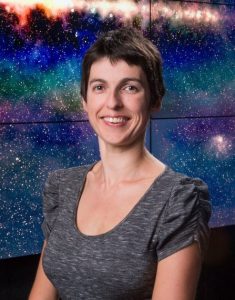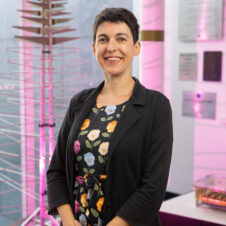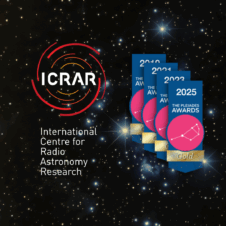After a nation-wide search ABC Radio National revealed this year’s winners of the ABC and University of New South Wales “Top 5” program for scientists — the search for Australia’s next generation of research talent. Listen to the announcement online.
ICRAR/Curtin researcher Dr Natasha Hurley-Walker was named, along with physiotherapist Dr Catherine Granger from the University of Melbourne, geneticist Dr Caitlin Curtis from the University of Queensland, materials scientist and engineer Dr Nasim Amiralian from the University of Queensland, and UNSW psychologist Dr Belinda Liddell.
The Top 5 scientists initiative is a partnership between ABC RN and UNSW. The five researchers will work at the ABC in the first two weeks of July — so look out for more from them next month.

Natasha Hurley-Walker. Image: ICRAR/Curtin
Astrophysicist Natasha Hurley-Walker knew from the age of seven that science was her destiny. From the moment she saw the Starship Enterprise “exploding out of the screen, in this great big fanfare of music”, she was hooked.
“I was always really fascinated by space and it kind of pushed me towards science,” she says. “I was one of those kids with the glow-in-the-dark stickers on the bedroom, I had all the planets in exactly the right order … I was obsessed with this stuff. For me, it was the best way of explaining the world.”
Dr Natasha Hurley-Walker
International Centre for Radio Astronomy Research, Curtin University node
Tell us about your research
My research is concerned with observing the universe and I use a novel technology called radio astronomy — though it’s not so much the field that’s new, but the instrument that I’m using and how I’m using it. The telescope is called the Murchison Widefield Array and it’s situated in outback Western Australia. I had this ambitious plan and idea to observe the whole sky. This is quite crazy for astronomers, because normally you just pick a little bit, pick a little object, and you look really hard at that.
We had taken some data from across the whole sky, across the whole telescope range of frequencies, and I thought “I think I could make an image of the whole sky”, in colour.
Why is your research important?
The telescope observes at these low frequencies and it also can observe over a really wide band. So it doesn’t just look at one little narrow frequency, which is what radio telescopes have done until very recently.
That means we can look at the radio colour [of objects in the universe]. If something is bright at low frequencies and dim at high frequencies it looks red in the radio telescope, and if something is the other way around … it kind of looks blue.
That colour aspect is really important. It allows us to immediately tell what things are, based on their colour. For example, we can look at these objects called radio galaxies, which are where there’s a black hole and it’s emitting massive plumes of gas into space. If it looks red … the jets are dying; if it’s blue, its jets have just started. Before, all you would know is that something was there, not what phase of life it was in.
This is a really fun view of the sky. And if you look at the radio colour image, it’s quite beautiful, because it’s just got all this fantastic colour in it.
What’s the best thing about your job?
I would say it’s the fact that I get to work with really, really smart people … I’m in awe of some of the other people in my department and we all have different skills. You put us all together and we can create fantastic things and discover amazing things about the universe.

